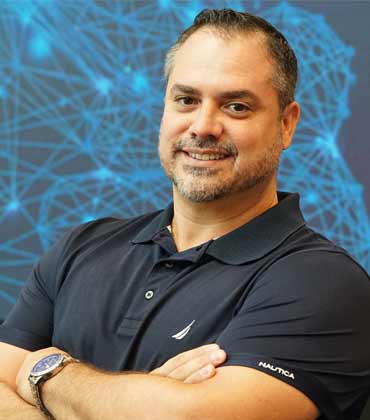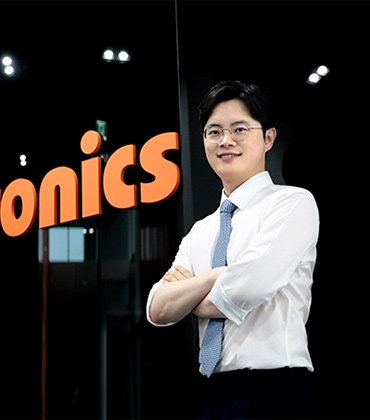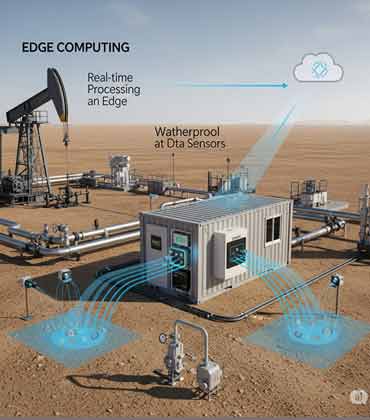THANK YOU FOR SUBSCRIBING
Applied Technology Review: Specials Magazine
Cognex Corporation (NASDAQ: CGNX), the global leader in machine vision systems, sensors, software and industrial barcode readers, is redefining manufacturing automation. The firm helps businesses meet rising consumer expectations for high-quality, cost-effective products by improving product quality, reducing production errors and optimizing operational efficiency. Established in 1981 in Natick, Massachusetts, Cognex Corporation has become synonymous with high-performance machine vision solutions that simplify automation for industry leaders. Its cutting-edge products fuel innovation and streamline operations across diverse sectors such as automotive, logistics, electronics, and medical devices. The foundation of Cognex Corporation lies in a groundbreaking vision to integrate human-like visual capabilities into industrial processes. This aspiration was spearheaded by Dr. Robert J. Shillman, an MIT lecturer specializing in human visual perception, and his graduate students, Marilyn Matz and Bill Silver. Together, they pooled their expertise in cognition and an initial $100,000 investment from Dr. Shillman to create Cognex—an abbreviation of “Cognition Experts.” The company’s debut product, DataMan, transformed manufacturing with its advanced optical character recognition (OCR) technology. This innovation enabled manufacturers to elevate quality control and reduce industrial waste with unparalleled precision, setting the stage for Cognex Corporation’s enduring legacy of industrial innovation. Over the years, the company has consistently adapted to the shifting demands of the industrial landscape. This commitment is evident in innovations like the In-Sight vision system, which combines advanced cameras with sophisticated software. The system enables real-time inspection and analysis, addressing the growing need for precision and efficiency in industrial operations. In addition, Cognex Corporation’s DataMan series offers stateof- the-art barcode readers that enhance logistics and supply chain operations traceability. As e-commerce grows, the firm’s vision systems are crucial in optimizing fulfillment centers. Cognex Corporation also serves an international customer base from offices in America, Europe and Asia, supported by a global network of integration and distribution partners. This extensive reach allows the company to deliver its advanced solutions to industries worldwide, ensuring that its innovations have a tangible impact on global manufacturing efficiency. In 2020, Cognex Corporation launched the In-Sight D900, a smart camera incorporating deep learning capabilities for defect detection and assembly verification. This breakthrough exemplifies the firm’s relentless pursuit of technological excellence, helping industries maintain a competitive edge in an increasingly automated world.
Nanotechnology
Nanotechnology has made big waves in tech innovations, transforming various industries with a broad spectrum of nanoscale marvels. However, dynamic business requirements prompted the technology to undergo a once-in-a-lifetime shift to align with the modern-day industrial landscape, often inundated by energy crises and various other challenges. The focus now is on developing new products that strike the right balance between increased performance and environmental sustainability. Perovskite nanomaterials are ideal for this shift, raising the bars of innovations while upholding operational efficiency. A leading innovator in the nanotechnology space, Quantonics Crystals (QC) is at the forefront of this much-needed industry-wide shift. It specializes in developing, manufacturing, and supplying high-quality advanced materials, such as perovskites, nanomaterials, quantum dots, graphenes, and carbon nanomaterials. Each of these products is carefully manufactured at its state-of-the-art facilities to cater to various needs across different industry verticals. From solar cell energy storage, sensors, and detectors to optoelectronics and photovoltaics, the QC product portfolio is ideal for numerous applications. QC’s products have also proven optimal for various medical applications, including cancer cell detection. As the guardian of environmental sustainability, QC has designed its eco-friendly quantum dots and lead-free perovskite to replace the hazardous materials often found in nanotech devices. It is a testament to the company’s commitment to building a cleaner and greener ecosystem for sustainable technological advancement.
Nanotech Solutions Provider
Technology development-oriented companies serve as the engines of innovation, propelling progress and shaping the future. These entities transform ideas from the realm of science fiction into the realities of tomorrow. Not only do they create new products, but they also reimagine how people live, work and interact with the world. A classic example of such a company is CEKO, which specializes in developing and manufacturing functional materials, coating agents and techniques for optical and digital devices such as displays, mobile devices and home appliances. “Our role is to blend technology with creativity, employing technological advancements to enrich performances and experiences, rather than incorporating new tech for its own sake,” says Kyungil Jun, vice president of CEKO. The company’s journey began with a challenging but crucial mission—to engineer a material that combines ultra-thin properties without compromising the original substrate’s integrity. This led to the development of a product in 2009, marking a paradigm shift in the touch-type display industry, transitioning cover glass processes to vacuum deposition, particularly for smartphones. Recognized for its ground-breaking properties at launch, Samsung Electronics quickly adopted the product, highlighting CEKO’s ability to meet and exceed industry expectations. CEKO has made remarkable strides in electron beam (E-Beam) methods, a sophisticated technique in vacuum deposition. The E-Beam process involves evaporating the coating agent using intense heat. CEKO has ingeniously developed proprietary synthetic materials and specialized containers to manage this high-temperature environment, ensuring safety and efficacy. At the heart of CEKO’s adherence to client requirements is its state-of-the-art research and development (R&D) center. The R&D center explores and develops new technologies and materials. Equipped with facilities and data reliability labs that rival larger corporations, this center testifies to CEKO’s dedication to cutting-edge research. It also specializes in optical and process technology, employing deposition machines that mirror the real conditions of an actual production environment. This practical approach ensures its products are ground-breaking and ready for mass markets.
Sensor Technology
Autonics began its journey in 1977 in South Korea, driven by a vision to make industrial automation smarter and more accessible. Over the years, that vision expanded across borders, and the company steadily grew into a trusted name in automation, now present in over 100 countries through a strong network of distributors and subsidiaries. As industries advanced and production demands became more complex, Autonics responded by developing technologies that brought greater precision, efficiency and flexibility to the factory floor. The company’s equipment has helped businesses build more responsive operations, giving them the tools to stay competitive in an environment where every second and every detail matter. A big part of that progress comes from Autonics’ ongoing commitment to research and development. Instead of simply keeping up with change, the company works to stay ahead of it. That mindset is reflected in a wide product lineup that includes sensors, controllers, motion devices, and human-machine interfaces—each designed to integrate seamlessly into manufacturing processes and support continuous improvement. Smart Technologies, Simple Integration Autonics is making waves with its range of automation products that work in synergy to solve industrial challenges. Its sensors are the backbone of many manufacturing systems, providing accurate detection, measurement and monitoring. These sensors allow for precise control, ramping up productivity, and keeping things running smoothly. Add in temperature controllers, timers, counters and panel meters, and it is all about maintaining peak performance and consistent quality. Motion control is another key area in which Autonics excels. The company develops and supplies stepper motors, drivers, and motion controllers that allow for high-speed, high-precision control of mechanical systems. These components are integral to automated machinery that requires reliable and repeatable motion, such as assembly lines and robotic applications. To top it off, Autonics’ human-machine interfaces simplify operator interaction, making it easier to monitor processes, troubleshoot, and improve overall transparency in operations.
CXO INSIGHTS

The Rise of Hyper Automation
Erdenezaya Batnasan, Head Of Information Technology Automation and Engineering Department, Khan Bank

New Nanotechnology Trend in the Healthcare and Cosmetic Industry
Jun Sasai, Vice President, Basic and Fundamental Research Dpt. Beauty Innovation Center, Finetoday Co., Ltd

Robotic Process Automation in Logistics: A Passionate Call to Action
Andre Pavei, IT Director, Ceva Logistics

Drone Application in Construction Industry
Henry Chan, Deputy Construction Manager, Dragages Hong Kong Limited

E is The Beauty of Esports
Yi Liu, Head of Gaming and eSports, Content+, Mindshare

Ai s Potential To Optimize Health Insurance Is Finally Being Realized. What's Driving The Change?
Claudio Caula, Head of Group Data Analytics, Aia [Hkg: 1299]

How AI Agents Can Supercharge Decision-Making in Construction
Christian Pallaria, Corporate Computational Design Manager & Sydney Mudau, Project and Program Aviation Sector Lead, Aecom [Nyse: Acm]
IN FOCUS
Exploring the Advantages and Challenges of Wearable Technology
Wearable technology offers benefits in healthcare, productivity, and convenience but faces challenges like data security, high costs, and integration issues.
Edge Computing at the Frontier: Powering Innovation in Remote Operations
Edge computing enhances remote operations by enabling real-time processing, reducing latency, improving security, and facilitating efficient resource use, driving innovation across various industries.
EDITORIAL
Driving Innovation: The Impact of Applied Technology Across Industries
Applied technology is rapidly reshaping the way industries operate by bringing scientific breakthroughs into everyday business practices. From artificial intelligence and automation to blockchain and the Internet of Things (IoT), these innovations are doing more than just improving efficiency—they’re unlocking new ways of working, connecting, and creating value. At the core of this transformation is artificial intelligence. No longer just about automating routine tasks, AI has become a strategic tool for smart decision-making and deeper customer engagement. Today’s machine learning models help businesses predict trends, fine-tune logistics, and deliver personalized experiences that were once out of reach. Complementing this is the Internet of Things, which links devices and systems in real time, giving organizations the ability to monitor operations, improve safety, and optimize resources like never before. As the volume of data shared and stored continues to grow, blockchain technology is stepping into the spotlight. Known initially for powering cryptocurrencies, blockchain is now driving trust and transparency across sectors—from reinforcing cybersecurity to streamlining supply chains and transforming financial transactions. But all these innovations depend on fast, reliable connectivity. That’s where 5G comes in. With its high-speed, low-latency capabilities, 5G is making real-time data processing a reality—paving the way for smarter cities, autonomous vehicles, and next-generation healthcare technologies. Of course, with more connectivity comes greater risk. Cybersecurity has become a top priority, as organizations face increasingly sophisticated digital threats. Many are turning to AI-powered defenses, zero-trust security models, and advanced encryption to protect sensitive data. At the same time, sustainability is gaining momentum as a key driver of tech innovation. Companies are investing in energy-efficient data centers, AI-led energy management, and green computing practices to reduce their environmental impact—without sacrificing performance. In this fast-moving landscape, it’s not enough for businesses to keep up—they need to stay ahead. Those who embrace applied technology are finding new ways to connect with customers, streamline operations, and stay competitive. As these technologies evolve, they’ll continue to redefine industries and improve lives, making applied tech one of the most exciting forces shaping our future.




![Cognex Corporation [NASDAQ: CGNX]: Redefining Machine Vision Across Industries Cognex Corporation [NASDAQ: CGNX]: Redefining Machine Vision Across Industries](https://www.appliedtechnologyreviewapac.com/newstransfer/upload/1-15gzo-.jpg)








